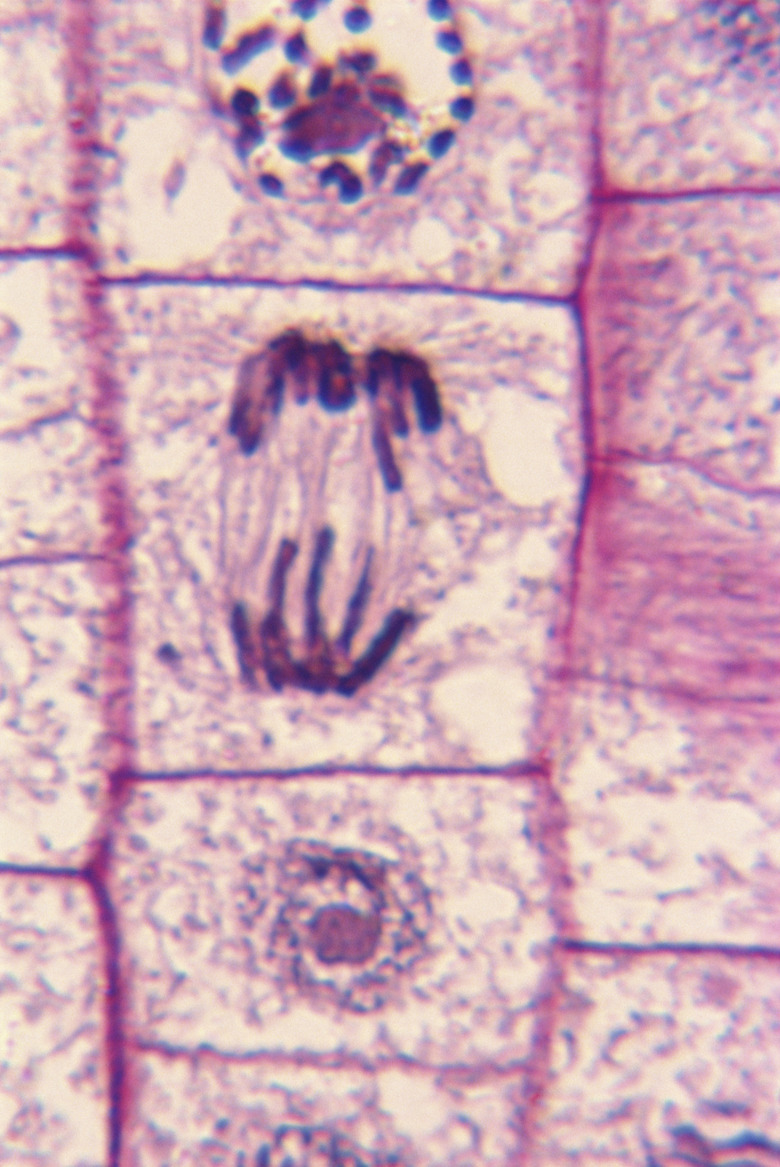What Forms Across The Center Of A Cell Near The End Of Telophase?
In prokaryotic single-celled organisms such as bacteria, cell division, and thus reproduction of the whole organisms, occurs in a process called binary fission. Here, the whole cell, which has grown slightly larger during its short lifetime, simply divides in two, including all of its genetic material in the form of DNA.
In eukaryotes, the picture is different. The cells of these organisms, which include plants, animals and fungi, are more complex, and confine their DNA to a membrane-bound nucleus. They also contain a number of specialized membrane-bound structures called organelles.
The nuclei of these cells and their contents divide asexually in a process called **mitosis**. This process is slightly different in plant cells than in other eukaryotic species owing to plant cells' unique features.
The Eukaryotic Cell
Eukaryotic cells, like all cells, have a cell membrane around the the outside, a cytoplasm (a gel-like matrix) on the inside, genetic material in the form of DNA, which in these cells sits within a nucleus and ribosomes, which are protein-like structures that themselves manufacture all proteins in cells.
Eukaryotic cells also have membrane-bound organelles including mitochondria, which handle aerobic respiration, the Golgi apparatus and endoplasmic reticulum, which process and move proteins and lysosomes.
Plant cells also have **chloroplasts**, which is where photosynthesis occurs.
The Cell Cycle
When a daughter cell forms from its parent, it starts its life cycle. This includes two broad periods, each of which has several stages of its own. Interphase is the first portion of the life cycle and the M phase is the second and last.
**Interphase** refers to the period of cell growth and development between mitotic divisions. In includes the G1 (first gap) phase, in which the cell gathers needed molecules, the S phase, when the cell replicates its DNA in the form of chromosomes and the G2 phase, where the cell checks its own previous work and gets the nucleus ready for mitosis.
The M phase includes the five individual steps of mitosis along with cytokinesis, the division of the cell in its entirety.
Cell Division: The M Phase
The M phase begins with mitosis and ends with the conclusion of cytokinesis. Cytokinesis actually begins before mitosis is complete, in the third of the four phases of mitosis. The M phase as a whole consumes considerably less of a fraction of the cell cycle in terms of time than does interphase, but it is a busy time.
Plant cells divide in the same general way as do animal cells, but the presence of a cell wall in plants requires a slightly different mechanism. This involves the formation of a structure called a cell plate. The cell plate is formed during telophase of mitosis, as explained below.
Mitosis Worksheet: Steps
• Prophase: Duplicated chromosomes (called sister chromatids) begin to condense in the nucleus and can now be easily seen under a microscope. The mitotic spindle, which will ultimately pull the chromatids apart, forms.
• Prometaphase: The chromosomes become linked to fibers of the mitotic spindle and begin to migrate toward the midline of the cell.
• Metaphase: The chromosomes align in the cell midline along the metaphase plate, with one chromatid on each side to ensure each daughter nucleus will receive one identical chromatid each.
• Anaphase: In this relatively dramatic step, the chromatids are pulled apart to opposite poles (ends) of the cell. Cytokinesis usually starts during anaphase.
• Telophase: In this step, the events of prophase happen more or less in reverse. A nuclear membrane forms around each new set of chromatids, and cytokinesis continues farther away, along the cell membrane.
Telophase and Cytokinesis in Plant Cells
In animal cells, cytokinesis gets underway with a simple pinching in of the cell membrane and cytoplasm within by a so-called contractile ring. In plant cells, however, the presence of a cell wall, which most eukaryotes lack, prevents this from happening.
Instead, a cell plate forms along the metaphase plate, growing inward from the sides of the rectangular plant cell. When it is complete, a new portion of cell membrane forms along each side of the cell plate, and the daughter cells, now complete, separate. When cytokinesis is completed, the two new daughter cells enter interphase.
Cite This Article
MLA
Beck, Kevin. "What Forms Across The Center Of A Cell Near The End Of Telophase?" sciencing.com, https://www.sciencing.com/forms-across-center-cell-near-end-telophase-8162/. 10 June 2019.
APA
Beck, Kevin. (2019, June 10). What Forms Across The Center Of A Cell Near The End Of Telophase?. sciencing.com. Retrieved from https://www.sciencing.com/forms-across-center-cell-near-end-telophase-8162/
Chicago
Beck, Kevin. What Forms Across The Center Of A Cell Near The End Of Telophase? last modified August 30, 2022. https://www.sciencing.com/forms-across-center-cell-near-end-telophase-8162/
